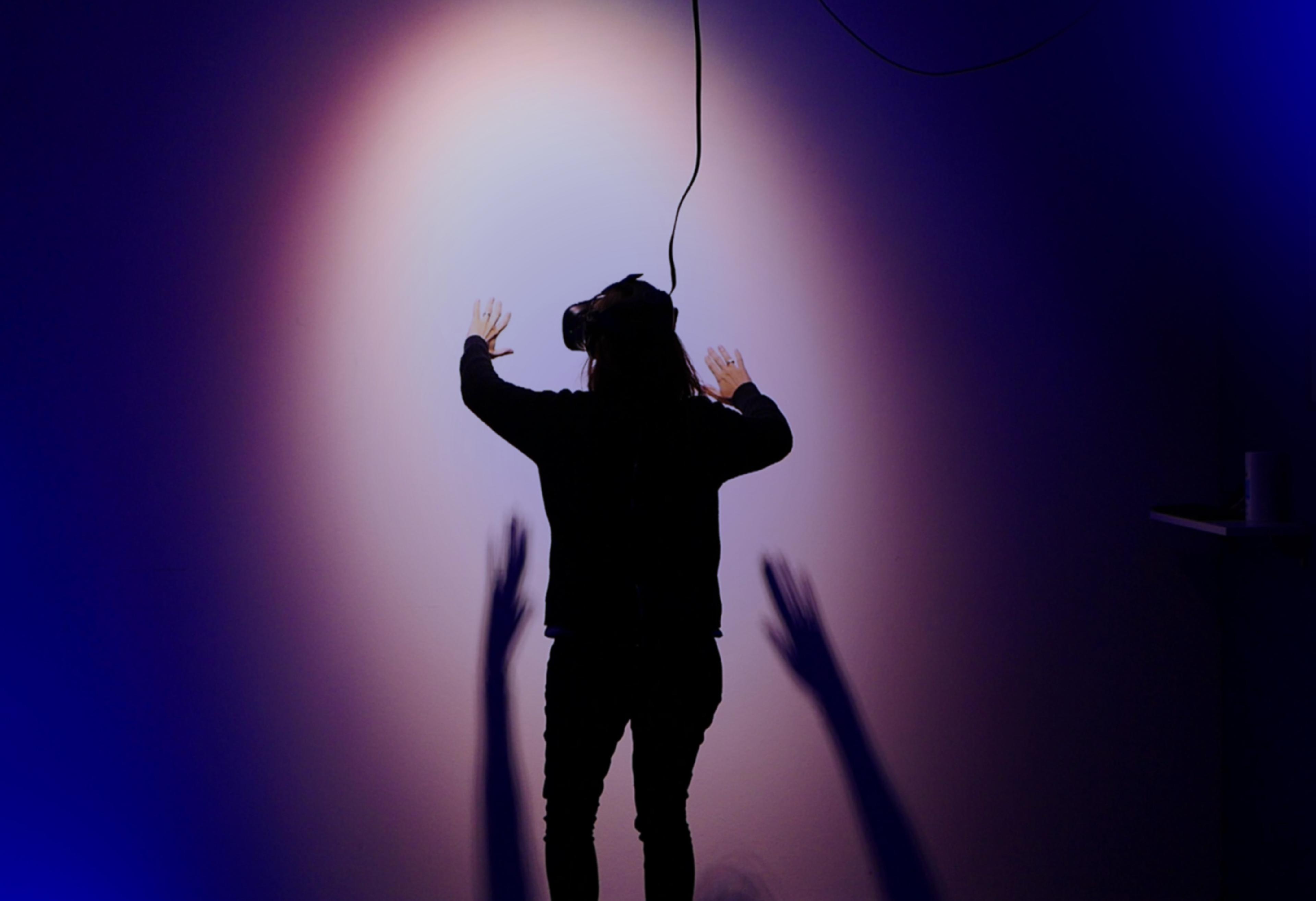
Metaverse tech stack explained


The metaverse is gaining significant traction within the business sector. Investment in AR and VR, technologies that form the bedrock of the metaverse, is anticipated to increase almost fourfold from $12 billion in 2020 to $72.8 billion by 2024. Furthermore, the market for extended reality (XR) — encompassing AR, VR, and MR — is predicted to achieve a valuation of $100 billion by 2026.
Consequently, frontrunners across sectors like gaming, retail, healthcare, video entertainment, and blockchain are strategizing to establish their presence in this domain. As the metaverse attracts more investments, it’s only natural for its technology stack to evolve.
Let’s have a deep look at how.
What is metaverse technology and how you can use it
The metaverse is a collection of digital ecosystems built on various kinds of 3D technology, real-time collaboration software, and blockchain-based decentralized finance tools. Like the many websites that form the internet, these digital ecosystems are self-sufficient — but can link and lead to each other to form an interconnected metaverse.
In the digital universes that make the metaverse, users can customize 3D avatars to interact with computer-generated environments and other users in real time. However, for that to happen, the underlying infrastructure demands a lot of different tech working in tandem.
The metaverse tech stack involves a combination of augmented reality (AR), virtual reality (VR), artificial intelligence (AI), 3D rendering, blockchain solutions, and cloud computing. Hardware-wise, users can access most metaverse applications through an extensive gadget list: from web browsers on PC, mobile, and tablet to dedicated AR glasses and VR headsets.
The technical architecture of metaverse applications
As with any computer program, the metaverse infrastructure consists of several layers, stacked on each other to form the final application. These work different from your usual app, though.
A simplified, but comprehensive version of the metaverse layer system has been popularized by the game developer and entrepreneur Jon Radoff. He proposes the existence of seven layers:
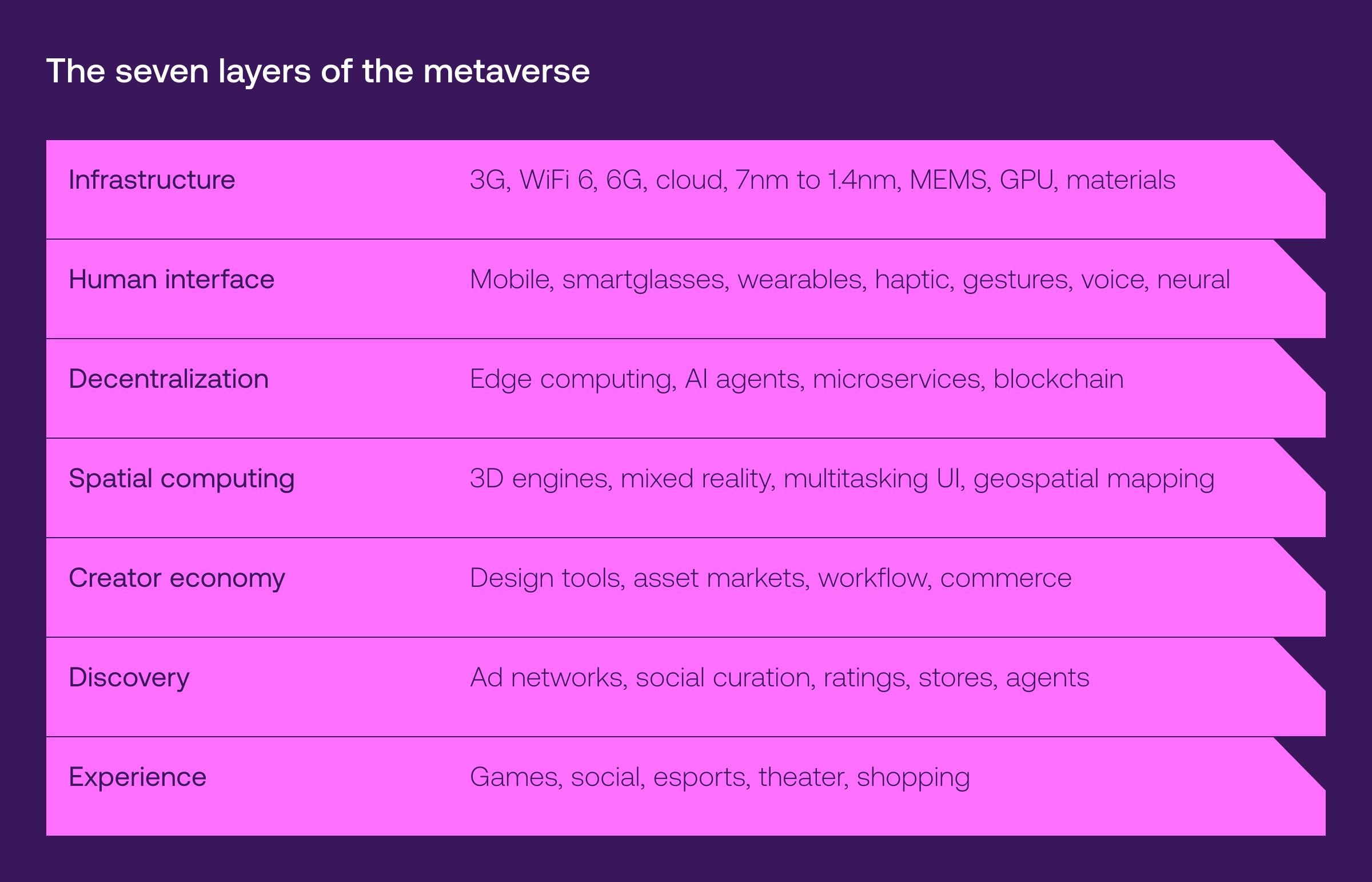
Let’s have a closer look:
Infrastructure layer
This layer contains the foundational physical elements of the metaverse, including the metaverse hardware, network infrastructure, and computing resources that support the virtual environment. It encompasses the servers, data centers, and cloud services that enable the creation and operation of the metaverse.
Human interface layer
This layer describes the physical devices that enable users to interact with the metaverse. It includes PCs, smartphones, VR headsets, AR glasses, haptic feedback devices, gesture and voice recognition tools, plus any other input/output mechanisms that enhance the user's ability to engage with the virtual space.
Decentralization layer
Decentralization is a key concept in many metaverse projects, with blockchain technology leveraged to distribute control and ownership. This layer involves decentralized systems for identification, traceability, and ownership of virtual assets.
Spatial computing layer
Spatial computing is where the metaverse’s code interacts with the physical world. This layer taps into AR/VR and 3D engines to map the user’s real-world environment and translate the digital experience to their spatial surroundings.
Creator economy layer
This layer focuses on the metaverse’s economic aspects that enable users to create, buy, and sell digital assets. It includes the creation of virtual goods, the establishment of marketplaces, and the integration of cryptocurrencies and non-fungible tokens (NFTs) to facilitate transactions.
Discovery layer
There’s much to explore in the metaverse, so discoverability is crucial. This layer involves technologies and systems that help users find and explore new virtual spaces, events, and experiences. It may include recommendation algorithms, search functionalities, and social curation features that enhance user discovery.
Experience layer
At the top of the hierarchy is the experience layer, which encompasses the overall user experience within the metaverse. This refers to what users can effectively do: the games, social interactions, entertainment content, and other immersive elements that make up the user's journey and activities.
Metaverse extended reality: AR and VR in virtual worlds
Extended reality (XR) is an umbrella term that encompasses AR and VR, along with other visual and tactile immersive technologies, which seek to provide a seamless blend of the real and virtual worlds. In the metaverse, XR allows users to transition between fully immersive virtual environments (VR) and augmented experiences in the real world (AR).
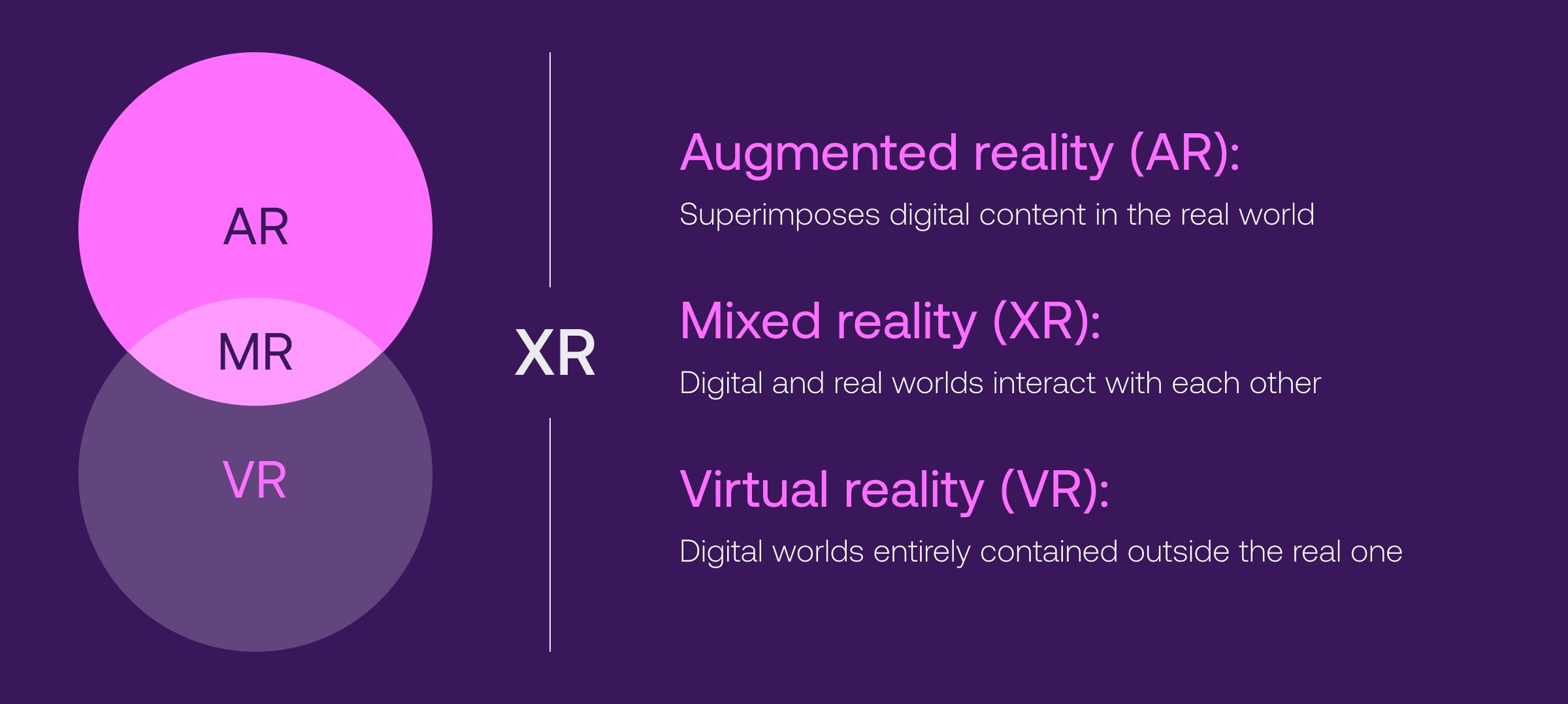
XR can support diverse applications in the metaverse: Mixed-reality experiences that combine virtual and physical elements, immersive storytelling, collaborative workspaces, and interactive education. All in all, the use of XR enables:
Enhanced immersion
Through XR, users can engage with virtual content and interact with each other in ways that feel increasingly realistic.
Spatial computing
The discipline that allows the metaverse to understand and respond to the physical world. Highly dependable on XR and crucial for creating modern interactive virtual environments.
Social interactions
XR injects a sense of presence in virtual environments, allowing users to feel like they are sharing a physical space with others.
Digital assets and environments
XR metaverse technologies support creating, exploring, and trading digital assets within the virtual environment. Users can build, buy, sell, and use their real-world bodies to interact with virtual objects and spaces.
Training and simulation
VR, in particular, is extensively used for training simulations in industries like healthcare and aviation, where access to training materials is costly. Digital environments enabled by XR contribute to creating realistic scenarios for learning and skill development.
Here are several tech stack options for metaverse development:
|
Programming languages |
Metaverse XR engines |
XR hardware |
|
C# |
Unity 3D |
Oculus Rift |
|
C++ |
Unreal Engine |
Valve Index |
|
Java (for Android) |
Maya |
HTC Vive |
|
Swift (for iOS) |
ARCore and ARKit |
Samsung Gear |
|
JavaScript |
VR SDKs |
Windows Mixed Reality |
|
GLSL |
A-Frame |
Microsoft HoloLens |
Metaverse and artificial intelligence
While AR and VR are the technologies that quickly come to mind when the topic is the metaverse, AI’s impact on virtual environments cannot be overstated. Albeit discreetly, AI enhances various aspects of user experience, interaction, and the overall functionality of virtual spaces. For example:
Realistic NPCs
NPCs, short for non-playable characters, are a mainstay of video games due to how they contribute to more immersive and dynamic virtual worlds. AI-powered NPCs exhibit realistic behaviors, respond naturally to user interactions, and simulate human-like actions, enlivening metaverse environments in surprising ways.
Behavior prediction and personalization
AI algorithms analyze user behavior and metaverse interactions to predict preferences and customize engaging user experiences. This personalization can include tailored content recommendations, adaptive gaming scenarios, and individualized virtual environments.
Content creation and generation
Generative algorithms can create virtual landscapes, objects, and even story narratives. This can help developers and creators efficiently populate virtual worlds with dynamic content, reducing the need for manual intervention.
Natural language processing (NLP)
AI-driven NLP facilitates communication within the metaverse. Users can talk with virtual entities or other users using voice or text, and AI helps in understanding and responding to these interactions in a contextually relevant manner.
Dynamic world adaptation
Virtual environments can evolve based on user behavior. This adaptability enhances the sense of immersion and agency within the virtual space, making the experience a lot more personal.
Security and moderation
Metaverse AI algorithms can detect and prevent inappropriate behavior, filter content, and enforce community guidelines. This softens the task of creating a safer and more inclusive virtual environment.
Here’s a general overview of the key AI technologies and tools that a metaverse developer might use:
|
AI frameworks and libraries |
NLP models |
Computer vision models |
Reinforcement learning algorithms |
|
TensorFlow |
BERT |
YOLO |
Proximal Policy Optimization |
|
PyTorch |
GPT |
Mask R-CNN |
Deep Q-Network |
|
Keras |
T5 |
Single Shot MultiBox Detector |
A3C |
|
Unity ML-Agents Toolkit |
XLNet |
EfficientDet |
Deep Deterministic Policy Gradient |
|
ONNX |
ERNIE |
DeepLab |
Trust Region Policy Optimization |
Metaverse 3D modeling and reconstruction
As the metaverse’s virtual environments demand state-of-the-art graphics to immerse users, 3D modeling and reconstruction are core disciplines to command. Some of their key aspects include:
Creation of virtual worlds
Realistic and well-designed virtual worlds provide the compelling metaverse experience that users crave through unparalleled immersion. Metaverse 3D models help, too.
Avatar and object design
High-quality and customizable avatars boost user representation, personalization possibilities, and self-expression in the virtual space. Detailed object design, a common strategy in Triple-A games to entice players, also contributes to dynamic and interactive environments.
User-generated content
Open-source 3D modeling tools empower users to create and contribute their own content to the metaverse, including virtual objects, buildings, and even entire environments. As seen in platforms like Minecraft and Roblox, user-generated content fosters creativity, diversity, and a sense of community where users can shape and personalize their virtual experiences.
Here are some of the tools that support metaverse-compatible 3D modeling:
|
3D modeling software |
3D scanning and photogrammetry |
3D rigging and animation |
Physics engines |
|
Blender |
RealityCapture |
Mixamo |
PhysX |
|
Autodesk Maya |
Meshroom |
Unity's Animation Rigging Package |
Unity Physics |
|
3ds Max |
Agisoft Metashape (formerly PhotoScan) |
Spine |
Unreal Engine's built-in physics |
Digital twins in the metaverse
Digital twins are virtual models of real-world processes and systems used to anticipate issues in supply chains and equipment maintenance. Digital twins are required, by definition, to be immersive, data-driven, and dynamic. In other words, it’s the perfect fit for the metaverse.
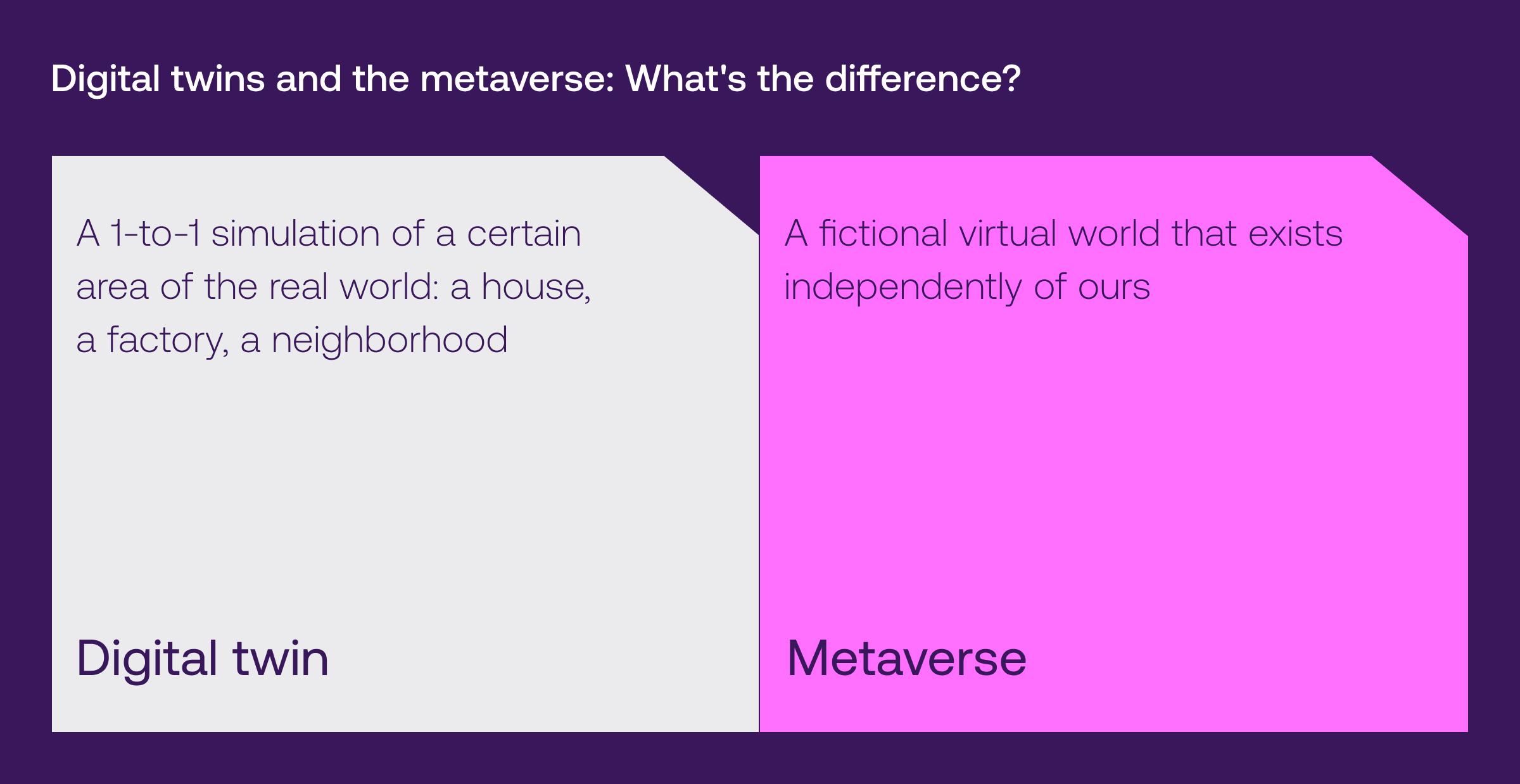
Here’s some of the ways digital twins and simulations influence the metaverse:
Virtual real estate and property development
Users can explore and interact with digital replicas of properties, participating in virtual property development and even commerce as prospective renters or buyers of the property’s real-world counterpart.
Smart cities and urban planning
Urban planners and policymakers can duplicate entire neighborhoods in the metaverse to visualize and analyze the impact of proposed changes. This moves data-driven decision-making forward in city development and infrastructure planning.
Maintenance and monitoring
Industries such as energy, manufacturing, and transportation already benefit from the real-time monitoring and predictive maintenance digital twins provide. Moving over to the metaverse is simply the next logical step.
Virtual prototyping and design
Architects, engineers, and designers can use the metaverse to visualize, test, and refine their designs in a dynamic and interactive environment.
Here's a tech stack compatible with metaverse development for digital twins:
|
Digital twin platforms |
Simulation and modeling tools |
Geospatial integration |
IoT integration |
|
AWS IoT Things Graph |
SIMUL8 |
Mapbox |
MQTT Protocol |
|
Microsoft Azure Digital Twins |
AnyLogic |
Google Maps API |
CoAP Protocol |
|
IBM Watson IoT Platform |
Unity3D |
Esri ArcGIS |
WebSocket |
|
PTC ThingWorx |
CityEngine by Esri |
HERE Technologies |
RESTful APIs |
Blockchain in the metaverse
Blockchain technology has a profound impact on the metaverse. The core blockchain concepts of decentralization, collectivity, and trust in new economic models have all been adopted in many B2C virtual environments. Metaverse and blockchain go hand in hand through:
Decentralization
By distributing control and ownership among participants, blockchain reduces reliance on centralized authorities and prioritizes user autonomy. In the metaverse, this means greater control over their virtual assets, identities, and interactions.
Digital asset ownership
Blockchain enables true ownership of digital assets via NFTs: verifiable digital assets stored on the blockchain. Metaverse users can create digital economies by buying, selling, and trading virtual assets such as virtual real estate, digital art, or in-game items with verifiable ownership.
Virtual economy and cryptocurrencies
Native cryptocurrencies or tokens can be used for transactions, rewards, and incentives. Users can earn, spend, and trade native digital currencies to kickstart new economic models and opportunities for content creators, developers, and participants.
Interoperability
The interoperability between different metaverse platforms can let users seamlessly transfer assets and even identities. Users can carry their virtual assets and identities across different metaverse environments for a more interconnected experience.
Here’s a general overview of a suitable blockchain tech stack for the metaverse:
|
Blockchain platforms |
Smart contracts |
Token standards |
Decentralized identity (DID) |
Interoperability protocols |
|
Ethereum |
Solidity / Rust |
ERC-20 / ERC-721/ ERC-1155 |
W3C Decentralized Identifiers |
Polkadot |
|
Binance Smart Chain (BSC) |
Truffle / Hardhat |
BEP-20 / BEP-721 |
Verifiable Credentials |
Cosmos |
|
Polygon (formerly Matic) |
MythX / OpenZeppelin |
MRC-20 |
DID Auth / DIDComm |
Wormhole |
Metaverse clouds: distributed or decentralized?
Metaverse cloud computing systems can be either distributed or decentralized. While the decentralized model is better known due to the relevance of decentralization for Web3 applications, both models are used for hosting metaverse ecosystems.
Choosing one over the other depends on the project’s technical capacity, intended performance, and specific requirements, but you can expect a cloud-native metaverse in both cases.
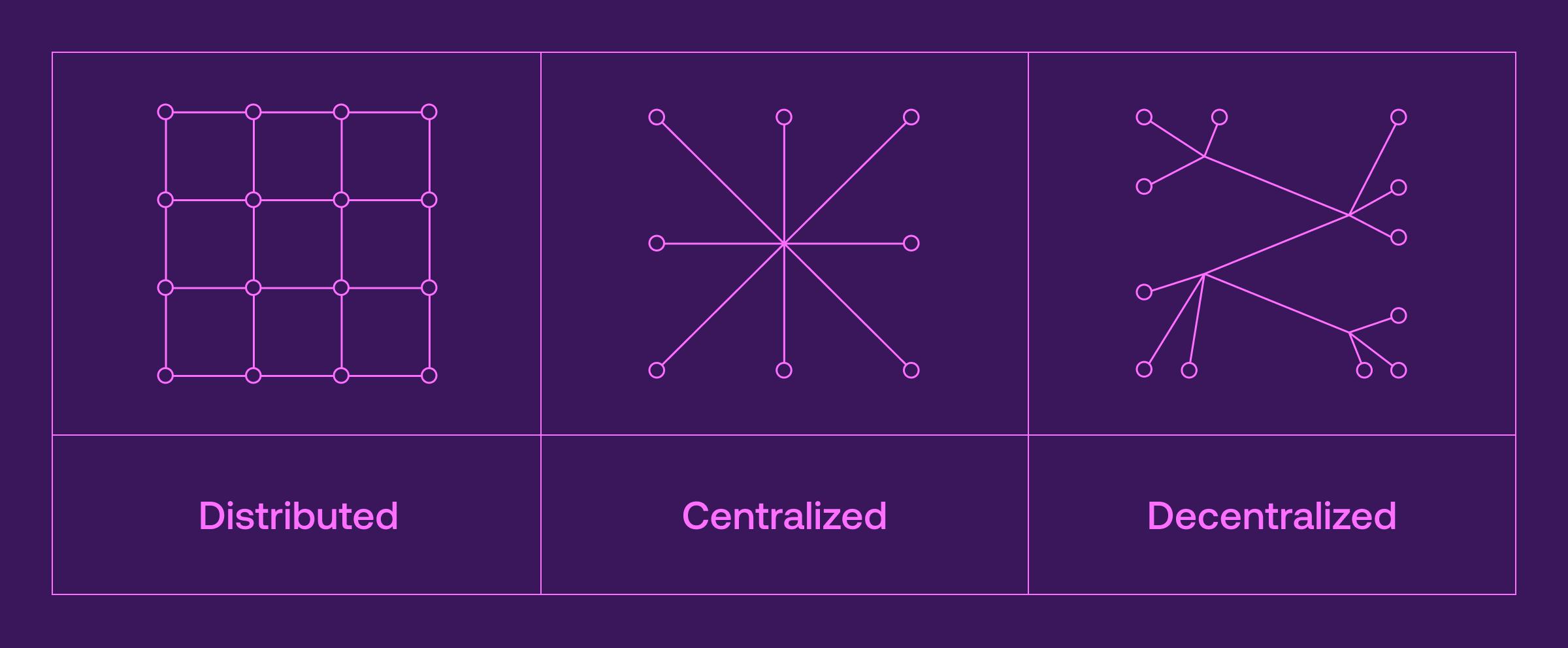
In a distributed cloud, the goal is to enhance performance, reduce latency, and provide redundancy. To achieve those, the cloud’s computing resources, data storage, and processing capabilities are spread across multiple data centers and even geographic locations. However, there’s still a central authority managing these distributed resources.
Scalability
Designed for scalability, distributed clouds share resources and workloads across multiple locations throughout the network. The enhanced performance allows metaverse applications to accommodate more users and process more transactions.
Latency and edge computing
Distributed clouds commonly leverage edge computing to reduce latency. By placing computing resources geographically closer to end-users, distributed clouds can enhance the responsiveness of metaverse applications.
Resource redundancy
Distributed clouds provide redundancy by having multiple instances of resources in different locations. This practice enhances fault tolerance and minimizes the risk of service disruptions, even in the face of hardware failures or other issues.
Below is a summary of the key tech stack for a metaverse distributed cloud:
|
Cloud infrastructure |
Distributed databases |
Decentralized object storage |
Load balancers |
Content delivery networks |
|
Amazon Web Services |
Amazon DynamoDB |
Amazon S3 |
AWS Elastic Load Balancing |
Amazon CloudFront |
|
Microsoft Azure |
Azure Cosmos DB |
InterPlanetary File System |
Azure Load Balancer |
Cloudflare |
|
Google Cloud |
Google Cloud Spanner |
Google Cloud Storage |
Google Cloud Load Balancing |
Akamai |
|
IBM Cloud |
CockroachDB |
Filecoin |
NGINX Load Balancer |
Fastly |
In a decentralized cloud, there is no central authority or single point of control. Instead, computing resources are distributed across a network of nodes, and decision-making is often achieved through consensus mechanisms.
Peer-to-peer networking
Necessary for direct communication between nodes, this architecture facilitates distributed data storage and processing. Peer-to-peer networking can contribute to efficient data retrieval and distribution within the decentralized cloud.
Blockchain integration
Decentralized clouds may integrate with blockchain networks, utilizing smart contracts and token-based systems for governance and resource allocation. Although blockchain solutions can make the network harder to scale, they provide a transparent environment for managing digital assets.
Data privacy and security
Decentralized clouds reduce the risk of large-scale breaches and enhance data privacy by distributing data across nodes. Further, the decentralized nature of data storage can be relevant to compliance and privacy regulations depending on the territories it’s stored.
Here’s a general overview of a decentralized cloud tech stack:
|
Decentralized storage |
Consensus mechanisms |
Oracles |
Cross-chain interoperability |
|
IPFS (InterPlanetary File System) |
Proof of Stake (PoS) |
Chainlink |
Bridges |
|
Filecoin |
Proof of Work (PoW) |
Band Protocol |
Cross-chain protocols |
|
Swarm |
Delegated Proof of Stake |
API3 |
Interoperability Protocols |
Looking for experienced metaverse engineers?
Ours excel in every technology you’ve seen so far.
Spatial computing, edge computing
Spatial computing and edge computing are two distinct yet complementary disciplines, each serving specific purposes within the metaverse's overall architecture. They aren’t either/or: Both can be included in any metaverse application if the project calls for those.
-
Spatial computing uses digital technologies to interact with the actual space of the physical world. It integrates digital information, such as virtual objects or AR elements, into the user's physical environment. Spatial computing can overlay virtual elements from the metaverse onto the real world, allowing users to interact with it.
-
Spatial computing metaverse use cases involve AR applications, mixed reality experiences, virtual object placement in physical space, interactive holograms, and spatially aware applications that respond to the user's surroundings.
Tech stacks of spatial computing for the metaverse include:
|
AR/MR platforms |
Spatial mapping |
Gesture / object recognition |
Spatial audio |
Cross-platform integration |
|
ARCore (Google) |
Unity MARS |
Ultraleap (Leap Motion) |
Google Resonance |
OpenXR |
|
ARKit (Apple) |
Google Sceneform |
Microsoft Kinect |
Microsoft Spatial Sound |
WebXR |
|
AR Foundation (Unity) |
Mapbox AR |
Google MediaPipe |
Oculus Audio SDK |
Unity3D with ARFoundation |
|
Microsoft Mixed Reality Toolkit |
HoloLens Spatial Mapping |
EasyAR |
Steam Audio |
Unreal Engine with Unrealamework |
|
Magic Leap SDK |
ARFoundation |
Maxst |
Wwise (Audiokinetic) |
A-Frame |
-
Edge computing involves processing data closer to the source of data generation (i.e. near the ‘edge’ of the network), minimizing delays and enhancing real-time capabilities. Edge computing reduces latency in metaverse applications, especially those requiring low-ping interactions, like gamified ecosystems.
-
Edge computing metaverse use cases involve real-time multiplayer gaming, collaborative virtual environments, live streaming of VR content, and any application where low latency is critical.
Tech stacks of edge computing for the metaverse include:
|
Edge computing platforms |
Edge computing software frameworks |
Edge database systems |
Edge networking protocols |
Edge deployment tools |
|
AWS Wavelength |
OpenStack Edge Computing |
Amazon DynamoDB Accelerator (DAX) |
MQTT |
Kubernetes (K3s) |
|
Azure Edge Zones |
LF Edge (Linux Foundation Edge) |
Azure Cosmos DB |
CoAP |
Docker Swarm |
|
Google Cloud Edge TPU |
AWS IoT Greengrass |
Redis Edge |
OPC UA |
AWS IoT Greengrass |
Internet of Things and the metaverse
The combination of IoT technologies with the metaverse ramps up the virtual space with even more interconnectivity and responsiveness. With the right tools, IoT integration makes the metaverse more realistic and shortens the gap between the physical and digital worlds.
-
Real-time sensor data
IoT devices equipped with sensors provide real-time data from the physical world. Cameras, accelerometers, and environmental sensors can all be used to create more dynamic virtual environments.
-
Wearables and biometric data
Metaverse wearable devices, such as smartwatches or fitness trackers, can capture biometric data, including heart rate, body temperature, and motion. Integrating this data into the metaverse enhances the personalization possibilities of users.
-
Smart home integration
Smart home devices, such as smart lights and thermostats, can be integrated into the metaverse. Users can control and interact with virtual environments by connecting them to real-world smart home devices.
-
Environmental interactivity
Devices can capture data about the physical environment, such as temperature, humidity, and lighting conditions. This information enables the creation of lifelike environmental simulations within the metaverse, mirroring actual weather conditions in the virtual space.
Below is an overview of the IoT in metaverse and its tech stack:
|
IoT connectivity protocols |
IoT platforms |
IoT data integration and analytics |
IoT prototyping and development platforms |
|
MQTT |
AWS IoT |
Apache Kafka |
Arduino |
|
CoAP |
Azure IoT |
InfluxDB |
Raspberry Pi |
|
WebSockets |
Google Cloud IoT |
AWS IoT Analytics |
Particle |
|
AMQP |
ThingSpeak |
Azure Stream Analytics |
Microsoft Azure IoT DevKit |
Wrapping up the metaverse technology stack
So, in short? Even for technologies so unbelievably revolutionary as the metaverse, the classic triad of the right engineers, sharp expertise, and a pulse on the times is a great place to start.
Not sure which metaverse technologies to use for your project?
Our experts can identify the perfect tools to elevate your product above the competition.



